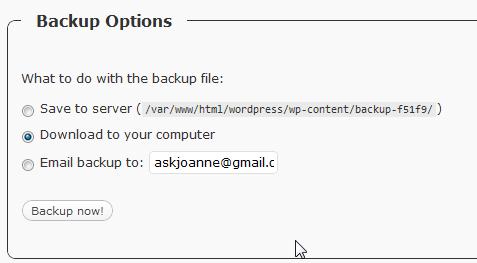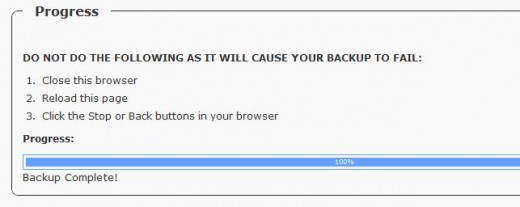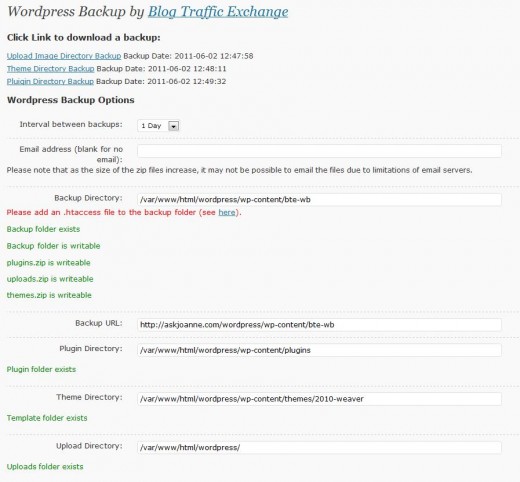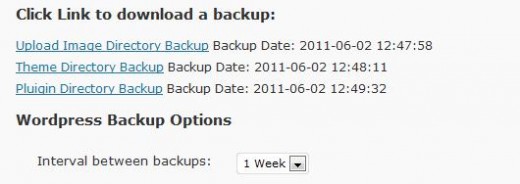- HubPages»
- Technology»
- Internet & the Web»
- Web Page & Web Site Development
How to Backup Wordpress Content and Format - Made Easy

Choosing a Backup Method for Wordpress
Backing up Wordpress is a very important task to know how to do. Updates for Wordpress come out very frequently and each update has the potential to cause problems with your setup, plugins or other parts of your website or blog. Unfortunately my initial research indicates that there is not one single automated backup and restore program that can do it all with one step. I found an article online at (http://www.carefulcash.com/the-3-best-backup-solutions-for-a-wordpress-blog/) that reviews several backup programs for Wordpress.
I tried using the Xcloner, which overall was fairly easy, but did require some technical knowledge of your site setup at the hosting account and the ability to create a special directory. Once I did that, the backup process was very easy, however, I had a great deal of trouble figuring out the restore procedure. It seems that Xcloner is mostly used for moving a blog from one website location to another, which was not what I wanted to be able to do.
There are premium (read "paid") services that you can use for Wordpress backups, but being frugal person, I am always looking for a free way to get done what I need done.
The Careful Cash article indicates that using two different backup programs, while a little bit of a hassle, is actually the easiest solution for backing up both your website content and your format/setup. Backing up both areas are important because while saving your site content (your page content and your blog posts) you also need to be able to backup the formatting and style options you’ve created for your site. If you chose one of the available templates and do not customize it all, updating will be easy and straightforward. However, in most cases your website will have been modified from the original template and will need to be restored in the case that any site upgrades affect your template setup.


Installing a WordPress Database Backup Plugin
The first plugin we're going to install is WP-DB-Backup, which is used for backing up the Content of the blog/website. Go to Plugins > Add New and search for WP-DB-Backup. Install the new plugin and then activate it.
Once the plugin is installed and activated, you can access it by going to Tools > Backup. The top of the screen shows you the parts of the blog/website that will be backed up, the second section gives you options to download the backup, have it emailed to you or have it saved to a directory on your site server. You can also schedule a backup to be completed daily, weekly or monthly and emailed to you.
Installing a Wordpress Site Backup Plugin
As mentioned earlier, the WP-DB-Backup plugin backs up only the CONTENT of the site and not the site setup and structure. This next plugin will backup the site structure and setup in case you ever need to restore those settings.
Follow the same procedure for installing a new plugin, Plugins > Add New and search for Wordpress Backup Plugin (the one recommended is by Blog Traffic Exchange.) This backup plugin is accessed via Settings > Wordpress Backup and does require certain site directories and files to be in place.

Wordpress Backup by Blog Traffic Exchange Settings
According to the initial settings screen, I have nearly all the appropriate directories already in place, the only item requiring attention is the addition of an .htaccess file in the backup directory they recommend: /var/www/html/wordpress/wp-content/bte-wb.
The link for more information on the .htaccess file brings you to a page on the Blog Traffic Exchange site with additional information on what needs to be in the .htaccess file.
Installing the plugin creates the backup directory on your site for you, all you need to do is add an .htaccess file with the code below to that directory. This can be done using the control panel at your site's hosting account.
RewriteEngine On
RewriteBase /
RewriteCond %{REQUEST_URI} .*bte-wb/.*
RewriteCond %{HTTP_COOKIE} !^.*wordpress_logged_in.*$ [NC]
RewriteRule . - [R=403,L]
Options All -Indexes
Once you've uploaded the .htaccess file as written, all the settings are in place for your backup. This plugin backups everything auto-magically and can be set to backup hourly, daily or weekly. At the top of the Backup settings page are the links that allow you do download your backups. The default settings have the backups created and saved at your hosting account, but for safety purposes, you should download these backups periodically to your computer hard drive or even to disk.
How to Backup Wordpress - Conclusion
So, now we have in place two plugins to handle the entire backup process for your Wordpress site. One to handle all your content, the other that backs up your uploaded images, your theme (and any modifications you've made to it) and your plugins.
Unfortunately I discovered that the restore procedures are not quite as easy and straightforward as the backup procedures (they require a bit more technical know-how), but I will create subsequent "How to" Hubs for how to restore your backups should disaster strike.








